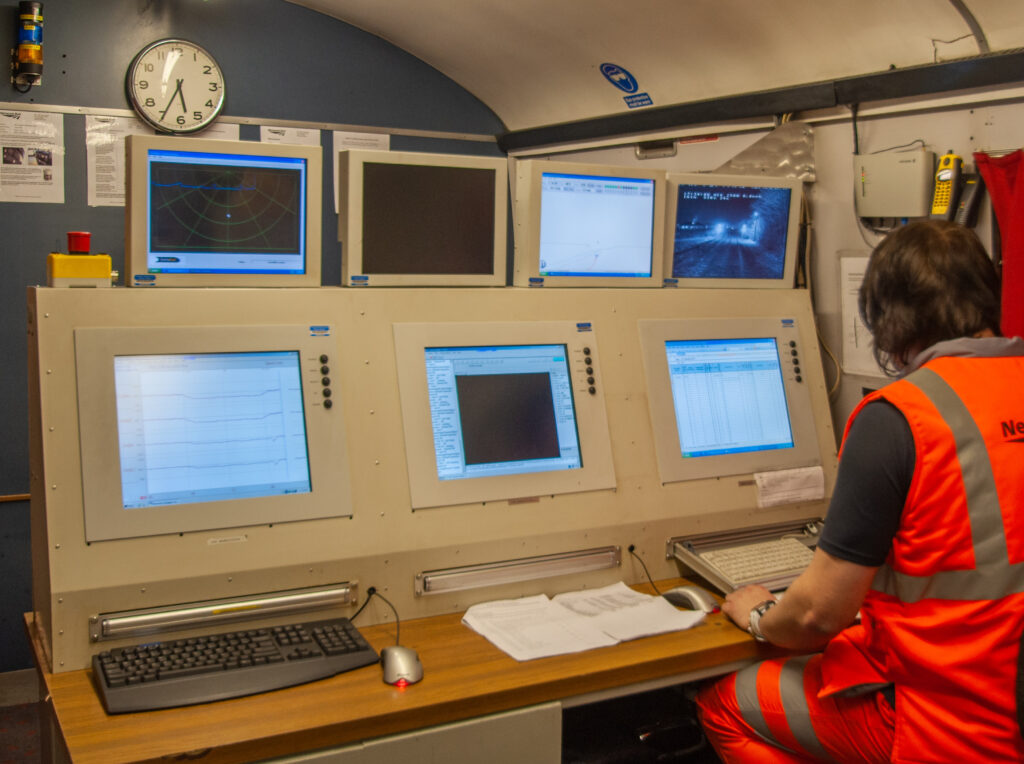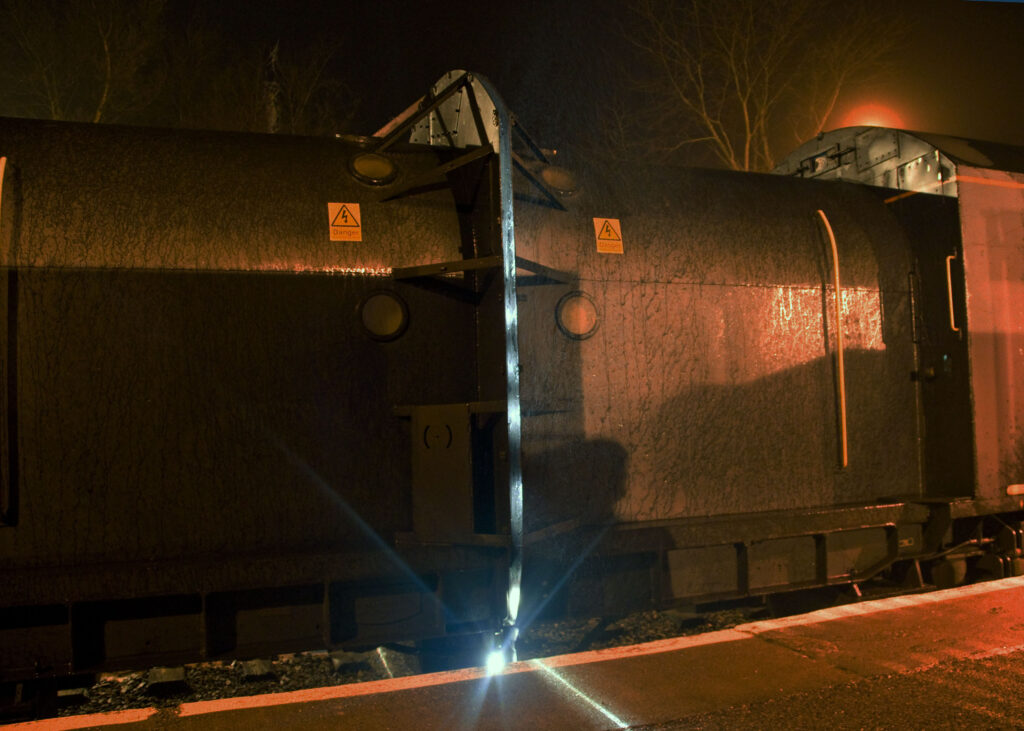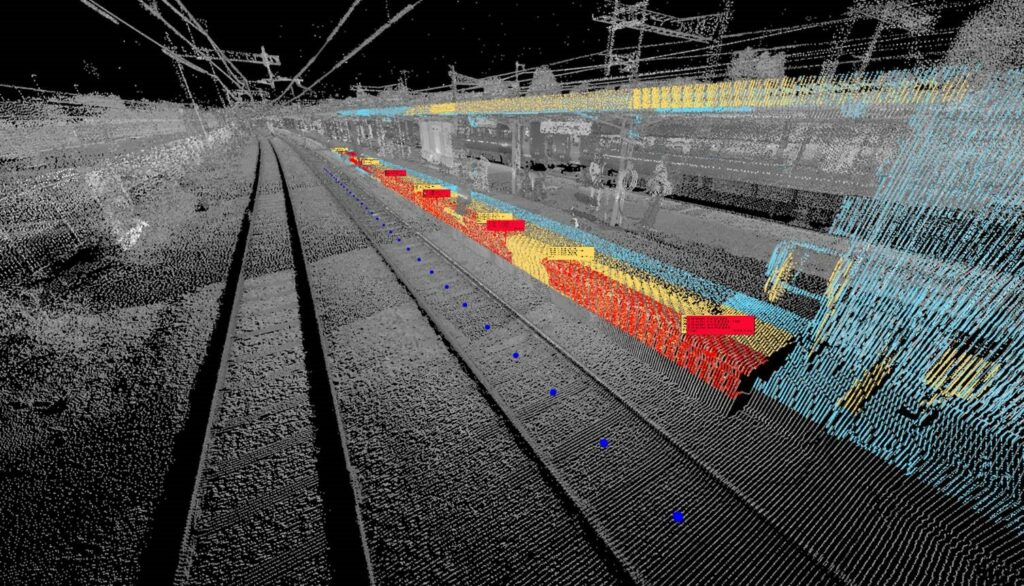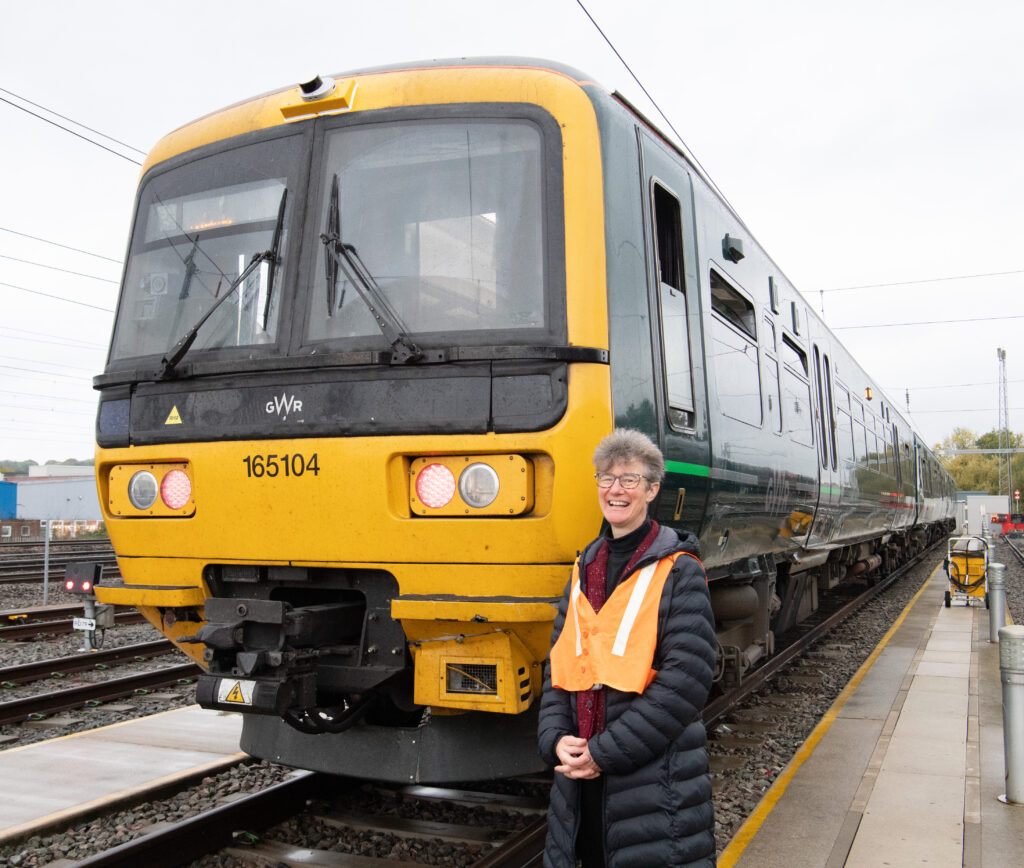Back in 2011, Rail Engineer went to Thurso, the most northerly part of the rail network, to ride on Network Rail’s Structures Gauging Train (SGT) which was then ‘state of the art’. This consisted of a Class 31 locomotive fitted with an infrared camera and headlights and four coaches which comprised: the structures gauging coach (SGC), an instrumentation & generator coach, a crew coach and brake runner coach (needed because the SGC was unbraked), and a driving trailer which was also fitted with infrared camera and headlights. These were used to avoid blinding the driver of any oncoming train.
Shining light into the darkness
The SGC was built by British Rail in 1981 and was one of the oldest in Network Rail’s infrastructure monitoring fleet. It projected a shielded, narrow beam of strong white light around the train whose reflections were detected by cameras and triangulated to measure distance. Where its light was projected, it was almost cut in two. It was also painted matt black to minimise stray reflections and so had an unusual look.
In 2009, its original halogen lights were replaced with the LaserFleX system which had an array of 45 lasers producing 855 micro beams whose reflections were detected by eight cameras which fed reflection data into software to produce a gauge profile. This system was mounted on the end of the SGC which was coupled to an adjacent coach with an extended coupler. The original white light system was kept as a backup.
While the previous BR system could only operate during the hours of darkness, LaserFleX could also perform acceptably in twilight and was largely unaffected by light pollution at stations. However, it could only operate at speeds up to 50mph, and for safety reasons could not be used below 7mph. Vegetation also had to be cleared before SGT runs to obtain accurate gauge profiles.
On the SGC, the LaserFleX was also supplemented by:
- A rotating laser scanning beneath the coach to measure the exact distance between adjacent tracks.
- Cant and curvature measurement using linear vertical differential transformers, accelerometers, and gyroscopes on the SGT’s bogies.
- Real time positioning system using GPS and twin tachometer encoders.
The SGC was withdrawn in 2013 and was replaced by a LaserFleX system fitted to the end of a Mk 2 coach coupled to another by an extended coupling. The SGT data provided composite profiles which are the worst-case gauge profile over five metres.
Today’s technology
Twelve years ago, train mounted collection of gauging information required a locomotive-hauled four coach train that could only operate at a maximum speed of 50mph during the hours of darkness. Today, the equipment required to do this, and more, fits into a unit mounted on an in-service passenger train’s coupler that can run at line speed at all hours of the day.
Since 2020, Fugro’s Railway Infrastructure Alignment Acquisition System (RILA) has been doing just this. RILA uses downward facing track scanners, LiDAR laser scanners, an inertial measurement unit (IMU), and video footage camera. Its scanner rotates at 250Hz and emits 1 million lasers pulses per second using LiDAR (Light Detection and Ranging) technology while GPS and IMU data is used to compute the position of the point cloud. It delivers:



Highly accurate rail head data of the rail heads which can be delivered as CAD data or other proprietary formats.
A high-density point cloud data of the entire rail corridor delivered in a range of industry standard formats (such as .LAZ, .POD, .PTS) for which data blocks can be further split into smaller sections as required.
Live video footage if the survey is undertaken in daylight hours delivered in standard formats. Location reference individual images can also be supplied.
RILA is accredited as Band 1A accuracy in Network Rail’s surveying standard NR/L2/TRK/3100. It provides highly accurate track data within 1mm, and the complete corridor 3D is positioned to an absolute accuracy of +/-8mm.
It takes about two minutes to mount the RILA Track unit on a train. This is done by a universal buffer adaptor for buffered vehicles, or via a bespoke automatic coupler adaptor for passenger trains. There is no electrical or data connection to the train. The unit uses batteries which last around 10 hours. If required, these can be swapped with charged batteries during a shift.
Once the unit is mounted on a train it is turned on and requires no other attention during the shift. However, a Fugro operative is required in case the train fails and the RILA unit must be removed to allow the failed train to be coupled to an assisting train. Data from the unit is collected from anywhere via an internet connection. Although RILA can operate at any time of the day, it is affected by heavy rain or snow and the video captured at night is of limited value.
Gauging Wales and Scotland
In 2020, Network Rail contracted Fugro to survey 843 route miles of its Western Route. This captured data on 14,897 structures over a six-week period, or 2,500 structures per week. Although the primary purpose of this survey was gathering data for gauging information, the data is also suitable for a range of other applications including vegetation analysis, ballast profiling assessment, topographical survey information, and measurement of heights and staggers on electrified routes. In 2021, the RILA system was used to survey Scotland’s railway network of over 3,200 route kilometres to provide gauging information. This included 669 station platforms and 4,715 bridges.
The outputs from the RILA system can be delivered through a secure web portal which integrates 2D and 3D data to provide a 3D model of the railway corridor. This allows route engineers and asset managers to view their acquired data in a desktop environment.
Until recently, data had to be manually processed before being entered on the NGD. This required skilled technicians to select and categorise the data and determine the type of structure. This was a significant bottleneck, especially with the increased amount of data to be entered from train mounted RILA surveys. In 2020, Atkins was awarded innovation funding to use Artificial Intelligence (AI) to enhance interpretation of point cloud data, and to use it to accurately locate and identify trackside features to provide accurate gauging clearance processing. This process is used to analyse RILA point cloud data for upload to the NGD.
AI is also used to separately classify vegetation from the RILA point cloud as vegetation needs to be cleaned out of this LiDAR data before a gauging profile can be created. This also enables the production of reports on vegetation encroachment. Fugro’s process to create gauging files for structures, platforms, and 6ft passing clearance is accredited to Network Rail’s structure gauge recording standard, NR/L2/TRK/3203.


Using passenger trains
It takes around three hours to manually gauge an individual structure. Doing this in the time it took the SGT to pass through the bridge at 50mph was clearly a significant improvement. Yet the NGD covers 16,000 route kilometres, 30,000 bridges, tunnels and viaducts, and thousands of signals, level crossings, and over 2,500 stations. Hence, maintaining this amount of data with a bespoke train that could only operate at night at 50mph was a significant challenge. Indeed, there were not sufficient train paths for the SGT to survey all of Network Rail’s infrastructure in the required timescale.
The development of the compact RILA unit that can be used on in-service trains significantly increases the rate at which gauging data can be collected. When combined with AI to rapidly process point cloud gauging data into the NGD, this will increase the accuracy of the database and ensure that it is up to date.
Since October 2022, Cordel has also been collecting gauging data from its Cordel Wave32 equipment installed in three GWR Class 165 DMUs based at Reading, which generate LiDAR point clouds and high-resolution video.
Railway Gauging Data Solution
As Malcolm Dobell explains in his feature ‘Gauging or Gouging’ (issue 202, May-June 2023) gauging is a complex issue requiring an assessment of the dynamic behaviour of the train. There are many limited clearance locations on the UK’s historic constrained infrastructure that require precise processes to get the best use of the network.
However, the lack of gauging information has caused various problems, including increasing the cost of introducing new trains, and preventing rail freight operators from promptly responding to potential customers who may require to move containers over a new route. Furthermore, often routes may be shown as not clear but not why. Yet work to clear the route to a larger gauge may be quite simple. Level boarding is also an important issue for which accurate gauging information is required.
The availability of accurate up-to-date gauging information is essential if the above issues are to be addressed. This requires both the frequent collection of gauging data, made possible from compact units mounted on service trains, and more effective processing of this data.

In December 2021 Cordel, which has partnered with gauging specialists D/Gauge, won a 6.5-year contract to replace the NGS with a more resilient new Railway Gauging Data Solution (RGDS) using its approved technology for processing gauging information. After 18 months of development RGDS went live as planned in August. As a result, hundreds of authorised users at Network Rail and third-party suppliers are now benefiting from sharper data flows, more consistent positioning of lineside structures, enhanced quality assurance, and shortened feedback loops which improve the integrity of the national gauging dataset.
Going forward, the RGDS IT architecture unlocks further potential to exploit modern ways of collecting and storing infrastructure data including machine learning. This includes being able to accept the larger data input from more frequent in-service passenger train surveys. In essence, RGDS will provide Network Rail and its customers with an end-to-end automated intelligent gauging solution that addresses the unique complexities of constrained UK railway gauging.
RGDS, together with the regular collection of data from Fugro and Cordel equipment, should ensure that problems from the lack of infrastructure gauging data will soon be a thing of the past.

